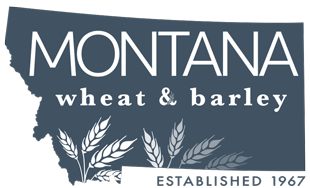Wheat Facts
- Our State
- Wheat
- Barley
- Durum
- Population: 1.14 million
- There are 2.5 cows per person
- Average rainfall 12-15 inches (30CM-38CM)
- Coldest recorded temperature -70F (-56C), Rogers Pass 1954
- Highest recorded temperature 117F (47C), Glendive 1893 and Medicine Lake 1937
- Montana holds the world record for largest 24 hour temperature change: 103 degrees from -54F to 49F (-47C, -9C), Loma 1972
In the United States, Montana is:
- Second in barley production, and first in planted acreage
- Third in wheat production
- Second in durum wheat production
- First in organic wheat production
- One bushel of Wheat equals 60 pounds, 42 commercial loaves of bread, one million kernels
- Wheat’s genome is one of the most complex known to man, five times larger than a human genome
- One pound of wheat seed can range from 8000-18000 kernels, always adjust your seeding rate!
- Winter wheat planting September-October, Harvest July-August
- Spring wheat planting April-May, Harvest August-September
- Based on a 20-year, Montana, all-wheat production average of 137,263,000 bushels, every man, woman, and child in Montana would have to consume at least 16 loaves of white bread a day for a whole year to use up the Montana production
- A combine can harvest enough wheat in 9 seconds to make 70 loaves of bread
- The vast majority of Montana’s exported winter wheat is used for oriental noodles
- 60-80% of our wheat production goes to the PNW for export
- Next to rice, wheat is the second most consumed calories in the world. In some countries it is the primary source of protein
- In 2020 the average US citizen ate 131lbs of wheat, Montana produced 11.94 billion pounds of wheat... We feed 91 million US citizens
- Never refrigerate bagels or any bread product. Bread products go stale up to six times faster in the refrigerator. Leave these products at room temperature or freeze them
- More than 17,000 years ago, humans gathered the seeds of plants and ate them. After rubbing off the husks, early people simply chewed the kernels raw, parched or simmered
- Wheat originated in the “cradle of civilization” in the Tigris and Euphrates river valley, near what is now Iraq
- In 2020, Montana’s Barley production equaled 13.5 BILLION cans of beer, serving every adult on the planet at least two Montana cervezas!
- One bushel of Barley equals 48 pounds or 300 cans of beer
- Barley is known to be the TRIPLE THREAT crop with three end uses: Food, Feed and Malt
- 20% of Montana’s Barley acreage is irrigated land
- Planting April-May, Harvest August-September
- Higher protein barley is desired for distilleries
- Low protein barley is desired for beer
- In the pacific rim, Barley tea is a popular drink
- Barley can be added to rice as an extender to enhance nutrition
- Barley was the model for the size of an inch. In 1324, King Edward II of England standardized the measurement as “three grains of barley, dry and round, placed end to end lengthwise”
- Beta glucan (β-glucan) is a soluble fiber readily available from oat and barley grains that has been gaining interest due to its multiple functional and bioactive properties
- One of the earliest cultivated crops known to man
- In John:6 Jesus feed 5000 people with just five loaves of barley bread and two fish.
- One bushel of Durum equals 60 pounds or 42 boxes of pasta
- If you eat pasta three times a week, it will take 70 weeks to eat all the pasta made from one bushel of durum
- Durum planting April-May, Harvest August-September
- Durum has high protein relative to wheat
- Semolina is coarsely ground durum with a texture somewhat like sugar, it is the best product for pasta
- In 1789 President Thomas Jefferson brought the first macaroni machine to the United States
- Freekeh is made from mid maturity durum then roasted in to a smokey tasty Mediterranean and North African dishes
- Kamut is an ancient variety of Durum
- There are over 600 different pasta shapes
